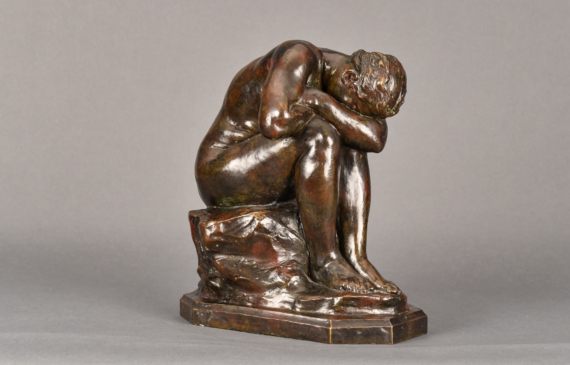
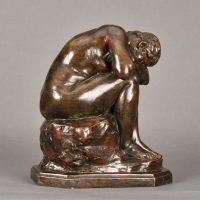
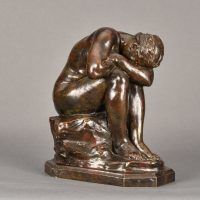
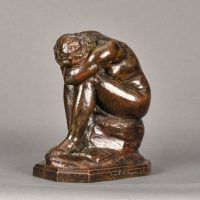
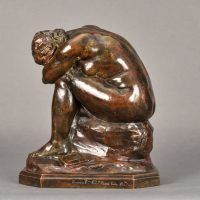
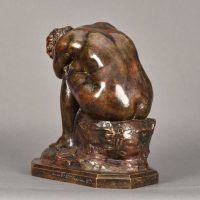
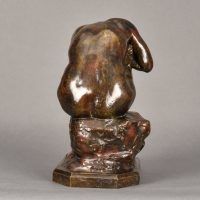
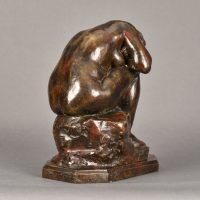
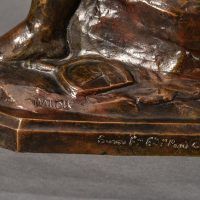
Aimé-Jules Dalou (French, 1838-1902)
La Verite Meconnue (The Truth Revealed), 1900
Bronze, brown patina, 13 ¼ H. inches
Signed: DALOU
Inscribed: Susse Fres Edt Paris Cire Perdue
The present model, known as La Vérité Méconnue or The Truth Revealed, belongs to a series of female nudes that Dalou produced between 1890 and 1900.
Dalou sculpted two versions of the composition. In the first version, the sitter’s hair is tied in a chignon and the mirror at her feet faces towards the front of the sculpture. In the second version the sitter’s hair isn’t tied and the mirror faces towards the back of the work.
The first version was only cast in one (20.5cm) size. The second version was cast in two sizes (14cm and 35cm). Both versions were cast by Susse Fres, Paris.
The present work is a cast of the second version in the larger size.
Aimé-Jules Dalou was a brilliant and iconic sculptor from France from the late nineteenth century. He is known for his grand monuments, decorative sculptures, reliefs, genre groups, and portrait medallions.
Born in 1838 in Paris, France, to a working-class family, Aimé-Jules Dalou was exposed to republican socialist ideals which laid the groundwork for his future political associations.
As a student, he was a pupil alongside Jean-Baptiste Carpeaux who sponsored his education at Petite École which later became École nationale supérieure des arts décoratifs. He then attended École des Beaux-Arts de Paris in 1954, where he studied under François-Joseph Duret. Although he did not enjoy Duret’s teaching style, this education influenced his talent, described as rich and detailed, with harmonious outlines. He also found inspiration from the intricate style of Giambologna.
He exhibited at the Paris Salon in 1861. However, due to his leftist politics he was denied the Prix de Rome, one that awarded winners a scholarship to learn art in Rome for a few years. So, instead of pursuing stardom, Dalou created decorative sculptures for boulevards and wax models for jewelry.
In 1871, he was exiled to England due to his participation in the Paris Commune, a radical socialist government, after the party was suppressed by the French Army. The new government exiled Dalou to England, forcing him to abandon his post as an adjunct curator at the Musée du Louvre. In England, Dalou became associated with the National Art Training School and New Sculpture movement. He also taught at the South Kensington School of Art. Important art works from this period include: The Charity Drinking Fountain (La Maternité) (1877-79) at the Royal Exchange, A Seated Angel with Five Infant Children (1878) commissioned by Queen Victoria for her private chapel, and many additional terracotta sculptures.
In 1879, Dalou was granted amnesty by the new republican leadership in France. Back in his homeland, Dalou completed his grandest sculpture yet, Triumph of the Republic in Place de la Nation (1889), to celebrate the new republican institutions of France. Important artworks completed by him in this period are the Monument to Delacroix (1890), dedicated to the French painter Eugène Delacroix in Luxembourg Gardens and Monument to Alphand (1899), a tribute to French engineer Adolphe Alphand.
Dalou was also the first president of the sculpture section within Société Nationale des Beaux-Arts, of which he helped found. And in 1889 he was awarded the Grand Prix of the Exposition Universelle, an exposition that celebrated the anniversary of the beginning of the French Revolution.
Aimé-Jules Dalou died in 1902, in Paris, France.
References:
Aimé-Jules Dalou (1897-1902). Online exhibition catalogue. London: Bowman Sculpture, 2014. Web. 29 November 2014.
Wikipedia,
http://portal.askart.com/auctionportal/DesktopDefault.aspx?tabindex=5&tabid=6